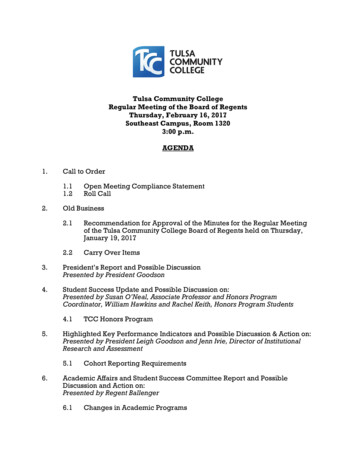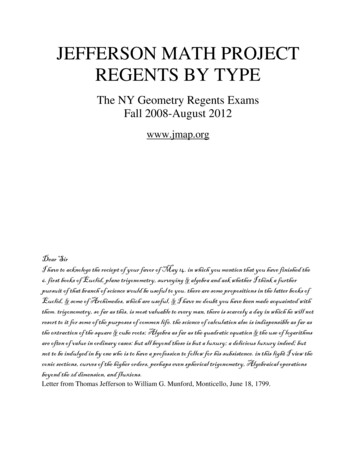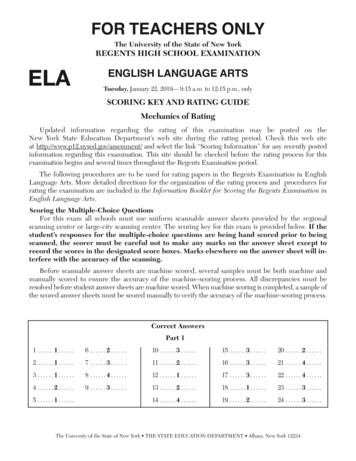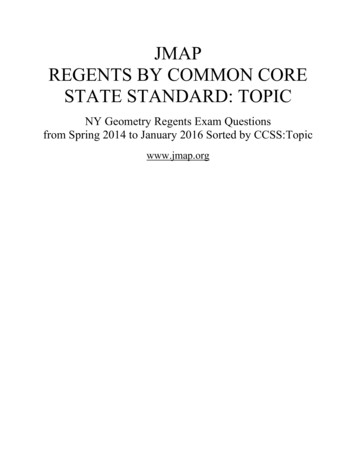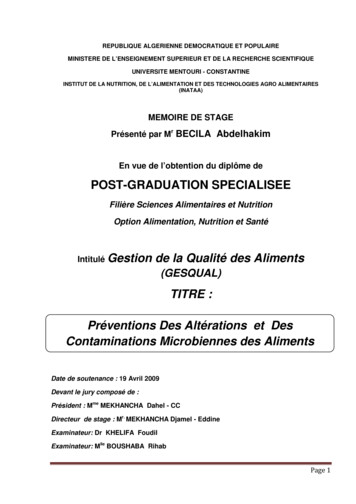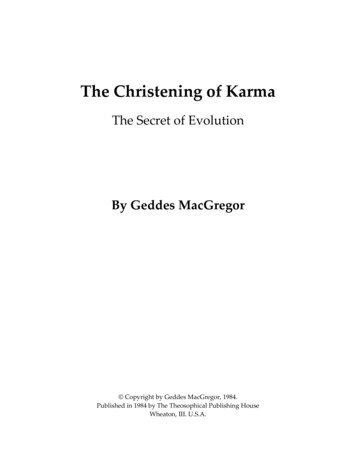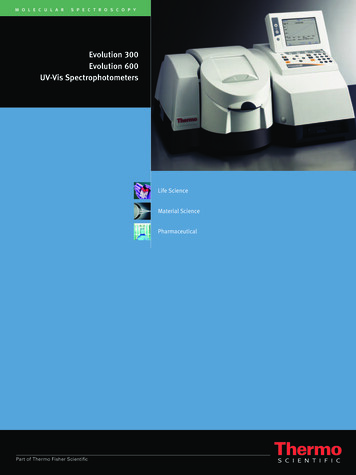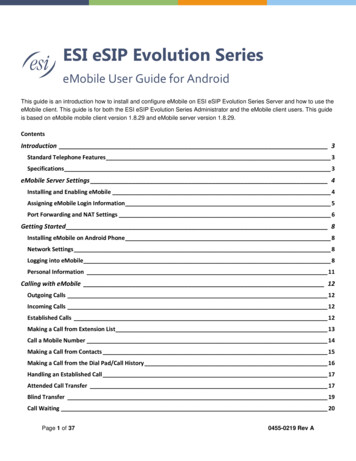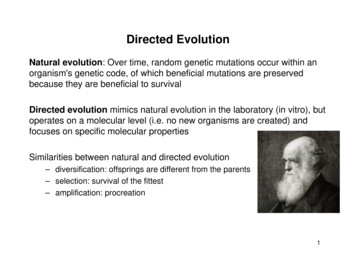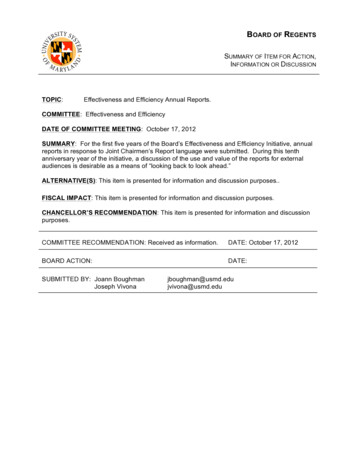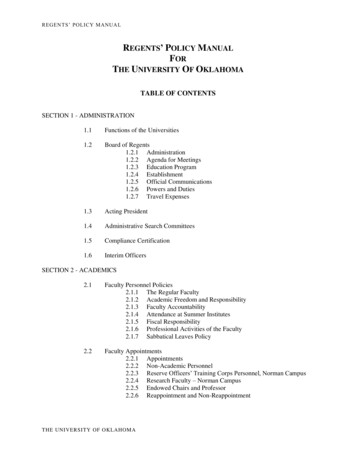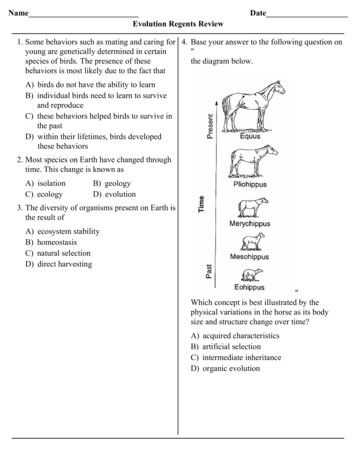
Transcription
NameEvolution Regents ReviewDate1. Some behaviors such as mating and caring for 4. Base your answer to the following question onyoung are genetically determined in certain"species of birds. The presence of thesethe diagram below.behaviors is most likely due to the fact thatA) birds do not have the ability to learnB) individual birds need to learn to surviveand reproduceC) these behaviors helped birds to survive inthe pastD) within their lifetimes, birds developedthese behaviors2. Most species on Earth have changed throughtime. This change is known asA) isolationC) ecologyB) geologyD) evolution3. The diversity of organisms present on Earth isthe result ofA)B)C)D)ecosystem stabilityhomeostasisnatural selectiondirect harvesting"Which concept is best illustrated by thephysical variations in the horse as its bodysize and structure change over time?A)B)C)D)acquired characteristicsartificial selectionintermediate inheritanceorganic evolution
5. In order for a species to evolve, it must beable toA)B)C)D)consume a large quantity of foodreproduce successfullymaintain a constant body temperaturebe domesticated6. The process of structural modification over along period of time that helps to explaindiversity of living things is known asA) metamorphosis B) successionC) migrationD) evolution7. Which statement concerning production ofoffspring is correct?A) Production of offspring is necessary for aspecies to survive, but it is not necessaryfor an individual to survive.B) An organism can reproduce withoutperforming any of the other lifeprocesses.C) Production of offspring is necessary foran individual organism to survive, whilethe other life processes are important fora species to survive.D) Reproduction is a process that requiresgametes in all species.8. Possible explanations for the differences inbody structures, body functions, and behaviorbetween various life-forms are included in theA)B)C)D)theories of organic evolutioncell theoryfossil records of vertebratesconcept of use and disuse9. Which statement represents the major conceptof the biological theory of evolution?A) A new species moves into a habitat whenanother species becomes extinct.B) Every period of time in Earth's historyhas its own group of organisms.C) Present-day organisms on Earthdeveloped from earlier, distinctlydifferent organisms.D) Every location on Earth's surface has itsown unique group of organisms.10. Comparative studies in embryology,biochemistry, and cytology provideinformation used by modern biologists toexamine new concepts about theA) function of mouth parts in thegrasshopperB) function of nephridia in the earthwormC) theory of use and disuseD) theory of organic evolution
11. The diagram below represents four different species of bacteriaWhich statement is correct concerning the chances of survival for these species ifthere is a change in the environment?A) Species A has the best chance of survival because it has the most geneticdiversity.B) Species C has the best chance of survival because it has no gene mutations.C) Neither species B nor species D will survive because they compete for the sameresources.D) None of the species will survive because bacteria reproduce asexually.12. Certain insects resemble the twigs of trees.Based on modern evolutionary theory, themost probable explanation for this is thatA) a single gene mutation caused theresemblanceB) the insects changed because they ate thewood of the treesC) genes were transferred from the trees tothe insectsD) natural selections of many variationshad occurred13. If the same antibiotic is used too manytimes, it can become less effective against acertain type of bacteria. This observation isbest explained by theA) presence of pathogens in antibioticsB) production of antibiotics by white bloodcellsC) replication of viruses that attackbacteriaD) survival and reproduction of unaffectedbacteria
14. The diagram below shows the effect of spraying a pesticide on a population of insectsover three generations.Which concept is represented in the diagram?A) survival of the fittestC) successionB) dynamic equilibriumD) extinction15. In an area of Indonesia where the oceanfloor is littered with empty coconut shells, aspecies of octopus has been filmed“walking” on two of its eight tentacles. Theremaining six tentacles are wrapped aroundits body. Scientists suspect that, with itstentacles arranged this way, the octopusresembles a rolling coconut. Localpredators, including sharks, seem not tonotice the octopus as often when it behavesin this manner. This unique method oflocomotion has lasted over manygenerations due toA) competition between octopuses andtheir predatorsB) ecological succession in marine habitatsC) the process of natural selectionD) selective breeding of this octopusspecies16. The graph below shows the results of aninvestigation related to evolution.This graph was most likely developed fromdata involving a study of theA)B)C)D)transmission of acquired characteristicsconcept of punctuated equilibriumconcept of gradualismvariation within a species
17. The concept that new varieties of organismsare still evolving is best supported by theA) increasing need for new antibioticsB) increasing number of individuals in thehuman populationC) decreasing number of new fossilsdiscovered in undisturbed rock layersD) decreasing activity of photosyntheticorganisms due to warming of theatmosphere18. Which statement is not part of the conceptof natural selection?A) Individuals that possess the mostfavorable variations will have the bestchance of reproducing.B) Variation occurs among individuals in apopulation.C) More individuals are produced than willsurvive.D) Genes of an individual adapt to achanging environment.
19. Base your answer to the following question on the information below and on yourknowledge of biology.Yes, This Big Lizard is PinkA new study from the University of Rome Tor Vergata shows that a rarestrawberry-tinted land iguana [rosada iguana] in the Galapagos Islands isgenetically distinct from other iguanas there, having diverged from them more thanfive million years ago as the archipelago [a group of islands] formed. The rosadaiguana—which escaped Darwin's notice—was discovered only recently, largelybecause it lives on the desolate slopes of an active volcano.Source: Smithsonian, March 2009Which diagram best represents the evolutionary pathway of the strawberry-tintediguana?A) 1B) 2C) 3D) 4
20. One concept that supports the theory ofevolution states that organisms best adaptedfor survival are the ones that will reproduceand pass traits on to future generations.Adaptations that can be passed on do notincludeA) the basic structure of the organismB) the reflex actions of the organismC) the manner in which the organismcarries out respirationD) techniques for hunting food taught bythe parents of the organism21. Even though the environment changes, apopulation that occupies a given geographicarea will most likely continue to be found inthis area if theA) variations in the population decreaseover timeB) members of the population decrease innumberC) members of the population exceed thecarrying capacityD) population passes on those genes thatresult in favorable adaptations22. Some of the concepts included in Darwin's theory of natural selection are representedin the diagram below.Which concept would be correctly placed in box X?A) use and disuseC) changes in nucleic acidsB) variationD) transmission of acquired traits
23. Natural selection and its evolutionaryconsequences provide a scientificexplanation for each of the following exceptA) the fossil recordB) protein and DNA similarities betweendifferent organismsC) similar structures among differentorganismsD) a stable physical environment24. Which factor has the greatest effect on therate of evolution of animals?A)B)C)D)environmental changesuse and disuseasexual reproductionvegetative propagation25. Which concept was not included by Darwinin his theory of evolution?A)B)C)D)overproduction in a populationstruggle for existencegenetic basis for variationssurvival of the fittest26. Which concept is best illustrated in the flowchart below?A) natural selectionC) dynamic equilibriumB) genetic manipulationD) material cycles
27. Which concept about variations is includedin the modern theory of evolution?A) Variations occur in animals, but not inplants.B) Variations are acquired and will appearin the offspring.C) Variations are the result ofoverproduction.D) Variations influence the survival of theindividual.29. A trait with low survival value to themembers of a population will most likelyA) undergo a series of mutations insucceeding generationsB) cause the reproduction rate inindividual organisms to increaseC) decrease in frequency from onegeneration to the nextD) remain unchanged in frequency throughmany generations28. The females of certain species of turtles will 30. Darwin's studies of finches on the Galapagossneak into a nest of alligator eggs to lay theirIslands suggest that the finches' differencesown eggs and then leave, never to return.in beak structure were most directly due toWhen the baby turtles hatch, theyA) acquired characteristics in the parentautomatically hide from the mother alligatorfinchesguarding the nest and go to the nearest bodyB) the size of the island where the finchesof water when it is safe to do so. Whichlivestatement best explains the behavior of theseC) mating behaviors of the different finchbaby turtles?speciesA) More of the turtles’ ancestors who actedD) adaptations of the finches to differentin this way survived to reproduce,environmentspassing this behavioral trait to their31. Buffalo grass is a species of plant found onoffspring.the glazing prairies of Wyoming. It is aB) The baby turtles are geneticallytough grass that has silicates (compoundsidentical, so they behave the same way.containing oxygen and silicon) thatC) Turtles are not capable of evolving, soreinforce its leaves. For hundreds of years,they repeat the same behaviorsthis grass has survived in an adversegeneration after generation.environment. Which statement best explainsD) The baby turtles’ ancestors who learnedthe presence of this grass today?to behave this way taught the behaviorsA) There are no variations in this grassto their offspringspecies that help it to survive in anadverse environment.B) Silicates are necessary forphotosynthesis.C) The current species has no mutations.D) The silicates in the grass have given thespecies an advantage in itsenvironment.
32. The graph below shows the percent ofvariation for a given trait in four differentpopulations of the same species. Thepopulations inhabit similar environments.35. The crucian carp, a Scandinavian fish,thrives in shallow ponds that freeze overduring winter. While other creatures in thepond die from lack of oxygen, these carp areable to obtain energy through a biochemicalpathway that does not require oxygen. Thischaracteristic is an example of aA) feedback mechanism common tocarnivores that inhabit shallow pondecosystemsB) favorable adaptive trait that has led toincreased survivalC) stage of succession that leads to a newcommunityD) gene mutation that occurred becausecarp need to survive to maintainecological stabilityIn which population will the greatest number36. Which group would most likely have theof individuals most likely survive if agreatest survival success during a longsignificant environmental change related toperiod of environmental changes?this trait occurs?A) a small population of rabbits living in aA) 1B) 2C) 3D) 4field of grass33. Which factor is least likely to contribute toB) a large population of red ants living in aan increase in the rate of evolution?forestC) an endangered population of polar bearsA) presence of genetic variations in aliving near an icebergpopulationD) one species of bird that nests only inB) environmental selection of organismssugar maple treesbest adapted to surviveC) chromosomal recombinations37. Which situation results in a characteristicD) a long period of environmental stabilitythat is inheritable?34. Limited resource contribute to evolutionarychange in animals by increasingA) genetic variation within the populationB) competition between members of thespeciesC) the carrying capacity for the speciesD) the rate of photosynthesis in thepopulationA) A limb is lost when two marineorganisms fight.B) A puppy learns to beg for food bywatching an older dog perform tricks.C) A gene is inserted into a bacterium,allowing the organism to produceinsulin.D) A random mutation causes theimmediate death of a microbe.
38. How does modern evolutionary theory relateto Darwin's concepts of variation and naturalselection?A) It includes Darwin's concept ofvariation, but not his theory of naturalselection.B) It includes Darwin's concept ofvariation and his theory of naturalselection.C) It does not include Darwin's concept ofvariation or his theory of naturalselection.D) It does not include Darwin's concept ofvariation, but it includes his theory ofnatural selection.39. The diagrams below show the bones in theforelimbs of three different organisms.Which hypothesis do the differences in thebone arrangements support?A) These organisms are members of thesame species.B) These organisms may have descendedfrom the same ancestor.C) These organisms have adaptations tosurvive in different environments.D) These organisms all contain the samegenetic information.
40. The evolutionary pathways of several species are represented in the diagram below.Which species was best adapted for survival in changing environmental conditions?A) AB) EC) K41. Which statement is not included as a part ofthe modern theory of evolution?A) Sexual reproduction and mutationprovide variation among organisms.B) Traits are transmitted by genes andchromosomes.C) More offspring are produced than canpossibly survive.D) New organs arise when they areneeded.42. A mouse has its tail completely cut off by amousetrap. Which concept proposes that theoffspring produced by this mouse will beborn without tails?A) gene linkageB) crossing-over between homologouschromosomesC) survival of the fittestD) inheritance of acquired characteristicsD) L43. The species of finches that Darwin found onthe Galapagos Islands displayed differentstructural and behavioral adaptations. Theseadaptations differed among the speciesaccording to the birds' varying habitats.Such adaptations most likely evolved as aresult ofA)B)C)D)use and disusetransmission of acquired characteristicsreproductive isolationgeographic isolation
44. Thousands of years ago, a large flock ofhawks was driven from its normal migratoryroute by a severe storm. The birds scatteredand found shelter on two distant islands, asshown on the map below. The environmentof island A is very similar to the hawk'soriginal nesting region. The environment ofisland B is very different from that of islandA. The hawks have survived on theseislands to the present day with no migrationbetween the populations.45. A large island in the Pacific Ocean supportsisolated populations of two groups of frogs.The following observations of these frogswere recorded by scientists.(A) Are different in color(B) Excrete different products(C) Live in different, isolated habitats(D) Can interbreed and produce fertileoffspringWhich observation best supports theinference that these frogs belong to the samespecies?A) AB) BC) CD) D46. The graph below represents the percent ofvariation for a given trait in four differentpopulations of the same species. Thesepopulations are of equal size and inhabitsimilar environments.Which statement most accurately predictsthe present-day condition of these islandhawk populations?A) The hawks that landed on island B haveevolved more than those on island A.B) The hawks that landed on island A haveevolved more than those on island B.C) The populations on islands A and Bhave undergone identical mutations.D) The hawks on island A have given riseto many new species.In which population is the greatest numberof individuals most likely to survivesignificant environmental changes related tothis trait?A) 1B) 2C) 3D) 4
47. The diagram below represents some changes that took place in a bacterial populationrecently exposed to an antibiotic.Which statement would best explain the presence of bacteria on day 4?A)B)C)D)A bacterial population cannot survive exposure to antibiotics.This bacterial population cannot survive exposure to this antibiotic.Bacteria can change whenever it is necessary to survive antibiotic treatment.Some of the bacterial population was resistant to this antibiotic.48. In 1993, there were only 30 panthers inFlorida. They were all closely related andmany had reproductive problems. To avoidextinction and restore health to thepopulation, biologists introduced 8 femalepanthers from Texas. Today, there are morethan 80 panthers in Florida and mostindividuals have healthy reproductivesystems. Why was this tactic successful?A) The introduced females produced morereproductive cells than the malepanthers in Texas.B) The introduced females solved thereproductive problems of the species byasexual methods.C) The introduced females increased thegenetic variability of the pantherpopulation in Florida.D) The introduced females mated onlywith panthers from Texas.49. Which species in the chart below is mostlikely to have the fastest rate of evolution?A) AB) BC) CD) D50. Darwin observed that different, but closelyrelated, species of finches filled the diverseenvironmental niches on the differentGalapagos Islands. The filling of theseenvironmental niches is known asA)B)C)D)acquired characteristicsblending inheritancecommon ancestryadaptive radiation
51. Which statement provides evidence thatevolution is still occurring at the presenttime?A) The extinction rate of species hasdecreased in the last 50 years.B) Many bird species and some butterflyspecies make annual migrations.C) New varieties of plant species appearmore frequently in regions undergoingclimatic change.D) Through cloning, the genetic makeupof organisms can be predicted.52. Base your answer to the following question on "the information and graph below and on your knowledge of biology.A small community that is heavily infested with mosquitoes was sprayed weekly withthe insecticide DDT for several months. Daily counts providing information onmosquito population size are represented in the graph below."What is the most probable reason for the decreased effectiveness of the DDT?A)B)C)D)DDT caused mutations inDDT was only sprayed once.Mosquitoes resistant to DDT lived and produced offspring.DDT chemically reacted with the DNA of the mosquitoes.
53. The diagram below represents the bones of55. The diagram below represents a processthe forelimbs of two animals alive today thatinvolved in reproduction in some organisms.most likely evolved from a commonancestor. Members of the original ancestralpopulation were isolated into two groups bynatural events.This process is considered a mechanism ofevolution becauseIf these two animals did have a commonancestor, which statement would bestexplain why there are differences in thebones?A) Changes occurred to help the animalsreturn to their original environment.B) Changes contributed to the survival ofthe organisms in their newenvironment.C) Changes helped reduce competitionwithin each group.D) Changes indicate the species areevolving to be more like the ancestralspecies.54. Beak structures differ between individuals ofone species of bird. These differences mostlikely indicateA) the presence of a variety of foodsourcesB) a reduced rate of reproductionC) a large supply of one kind of foodD) an abundance of predatorsA) mitosis produces new combinations ofinheritable traitsB) it increases the chances of DNAalterations in the parentC) it is a source of variation in theoffspring producedD) meiosis prevents recombination oflethal mutations56. In a group of mushrooms exposed to apoisonous chemical, only a few of themushrooms survived. The best explanationfor the resistance of the survivingmushrooms is that the resistanceA) was transmitted to the mushrooms fromthe poisonous chemicalB) resulted from the presence of mutationsin the mushroomsC) was transferred through the food web tothe mushroomsD) developed in response to the poisonouschemical
57. If a species of bear in Russia and the brownbear in the United States have a commonancestor, the differences between these twospecies most likely resulted fromA)B)C)D)mutations and genetic recombinationmutations and asexual reproductionthe inheritance of acquired traitsthe development of structures forclimbing trees58. Which observation provides the bestevidence that two different animals mostlikely have a common ancestor?A) They choose the same plants for food.B) They both burrow into the ground forshelter.C) They have similarities in earlyembryonic development.D) They both inhabit the sameenvironment.59. Two organisms are closely related and arethought to share a similar evolutionaryhistory. If this assumption is correct, theseorganisms most likely haveA)B)C)D)60. From the information given in the chartbelow, which two organisms are mostclosely related?no structural differencesfew biochemical similaritiesidentical chromosome mutationssimilar embryological developmentA) A and BC) C and DB) B and CD) D and B61. Two nucleotide sequences found in twodifferent species are almost exactly thesame. This suggests that these speciesA)B)C)D)are evolving into the same speciescontain identical DNAmay have similar evolutionary historieshave the same number of mutations62. To determine evolutionary relationshipsbetween organisms, a comparison wouldmost likely be made between all of thecharacteristics below exceptA)B)C)D)methods of reproductionnumber of their ATP moleculessequences in their DNA moleculesstructure of protein molecules present
63. A classification system is shown in the tablebelow.In this classification scheme, the rectanglerepresents a species that is most closelyrelated to which other species?A)B)C)D)64. The blood of rhesus monkeys containsproteins similar to those found in the bloodof humans. This observation suggests thatrhesus monkeys and humansA)B)C)D)belong to the same genusmay have a common ancestorhave identical chromosomesoccupy the same niche
65. Base your answer to the following question on the diagram below and on yourknowledge of biology. Letters A through L represent different species of organisms.The arrows represent long periods of geologic time.Which two species are the most closely related?A) J and LB) G and LC) F and HD) F and G66. According to the interpretation of the fossil record by many scientists, during whichtime interval shown on the time line below did increasingly complex multicellularorganisms appear on Earth?A) A to BB) B to CC) C to DD) D to E
67. Which statement concerning the evolutionof species A, B, C, D, and E is supportedby the diagram below?A) Species B and C can be found intoday's environments.B) Species A and D evolved from E.C) Species A and C can still interbreed.D) Species A, B, and E all evolved from acommon ancestor and all are successfultoday.68. The diagram below illustrates possibleevolutionary pathways of some species.Which statement is a valid inference basedon the information in the diagram?A) Species A is the common ancestor ofall life on Earth.B) Species D is more closely related tospecies E than to species F.C) Species B is the ancestor of species F.D) Species C is the ancestor of species thatexist at the present time.
69. The diagram below represents undisturbedrock strata in a given region. Arepresentative fossil of an organism isillustrated in each layer.71. The diagrams below illustrate threehomologous structures.Which statement best describes arelationship between these representativeorganisms?The structural similarities represented in thediagrams are considered supportingevidence forA) Organism A was probably morestructurally advanced than organism Band organism C.B) Organism C probably gave rise toorganism A and organism B.C) All of these organisms probablyevolved at the same time.D) Organism A was probably moreprimitive than organism B andorganism C.A)B)C)D)70. If all species originated on the primitiveEarth at the same time and did not change,which pattern would be expected in thegeologic record?A) The lower rock strata would containfossils of only the simpler organisms.B) The upper rock strata would containfossils of only the simpler organisms.C) The upper rock strata would containfossils of only the more complexorganisms.D) Both the lower and upper rock stratawould contain fossils of more complexorganisms.the heterotroph hypothesisa common ancestryuse and disusegeographic isolation
72. The remains of three organisms are shown below.A study of these remains would indicate that these organisms haveA) identical food preferencesC) structural similaritiesB) identical body sizesD) habitat similarities73. Which term describes appendages that mayhave different functions, but are similar instructure an are assumed to have the sameevolutionary origin?A) fossilsC) homologous74. Base your answer to the following questionon the diagram below.B) homozygousD) mutationsWhat do the similarities of the bones labeledA provide evidence for?A) the organisms may have evolved from acommon ancestorB) all species have one kind of bonestructureC) the cells of the bones contain the sametype of mutationsD) all structural characteristics are thesame in animals
75. Base your answer to the following questionon the diagram below and on yourknowledge of biology. The diagramillustrates one possible scheme of evolutionamong various groups of organisms.77. A species that lacks the variation necessaryto adapt to a changing environment is morelikely toA)B)C)D)develop many mutated cellsbecome extinct over timebegin to reproduce sexuallydevelop resistance to disease78. When is extinction of a species most likelyto occur?Which inference does the diagram bestsupport?A) Members of the animal kingdom aremore complex than members of theplant kingdom.B) Members of the animal kingdom andmembers of the plant kingdom share acommon ancestry.C) Chordates are more closely related toarthropods than to echinoderms.D) Members of the phylum Echinodermataand the phylum Annelida share acommon ancestry.76. Which factor contributed most to theextinction of many species?A) changes in the environmentB) lethal mutationsC) inability to evolve into simpleorganismsD) changes in migration patternsA) when environmental conditions remainthe same and the proportion ofindividuals within the species that lackadaptive traits increasesB) when environmental conditions remainthe same and the proportion ofindividuals within the species thatpossess adaptive traits increasesC) when environmental conditions changeand the adaptive traits of the speciesfavor the survival and reproduction ofsome of its membersD) when environmental conditions changeand the members of the species lackadaptive traits to survive and reproduce79. Which population of organisms would be ingreatest danger of becoming extinct?A) A population of organisms having fewvariations living in a stableenvironment.B) A population of organisms having fewvariations living in an unstableenvironment.C) A population of organisms having manyvariations living in a stableenvironment.D) A population of organisms having manyvariations living in an unstableenvironment.
80. According to the fossil record, whichstatement is accurate?A) Most of the species that have lived onEarth no longer exist.B) Most of the species that have lived onEarth still exist today.C) Fossils of species that never existed canbe found.D) Fossils of species that never existed,but will exist in the future, can befound.81. Many scientists suggest that billions of yearsago, life on Earth began withA)B)C)D)simple, single-celled organismssimple, multicellular organismscomplex, single-celled organismscomplex, multicellular organisms82. Base your answer to the following question on the chart below and on your knowledgeof biology.According to most scientists, which sequence best represents the order of biologicalevolution on Earth?A) AC) BBACCB) BD) C83. According to the heterotroph hypothesis,which gas given off by autotrophic activitymade the evolution of aerobes possible?A) oxygenB) hydrogenC) carbon dioxide D) nitrogenCAAB
84. The diagram below represents the apparatusused by Stanley Miller to provideexperimental evidence to support theheterotroph hypothesis.In which parts of the setup did he attempt toduplicate the energy sources of the primitiveEarth?A) A and DC) C and AB) B and CD) D and B85. According to the heterotroph hypothesis,energy sources for the formation of the firstorganic molecules from inorganicsubstances did not includeA) glucoseC) lightningB) heatD) radiation86. According to some scientists, what resultedfrom the environmental conditions existingon primitive Earth illustrated below?A) evolution of the first heterotrophs fromaggregates of organic moleculesB) development of heterotrophic forms oflife from plantsC) migration of vertebrates to coolerportions of EarthD) decrease in asexual reproduction inprimitive organisms
87. Base your answer to the following question on the graph below and on yourknowledge of biology. The graph shows the number of species that became extinctfrom 1800 to 2000. It also shows estimates of the number of species that will becomeextinct between 2000 and 2020.The number of species that became extinct between the years 1950 and 2000 isapproximatelyA) 5,000B) 12,000C) 22,000D) 37,000
88. Base your answer to the following question on "the information below and on your knowledge of biology.The three great lakes in Africa (Victoria, Tanganyika, and Malawi) contain a greaternumber of fish species than any other lakes in the wo
floor is littered with empty coconut shells, a species of octopus has been filmed "walking" on two of its eight tentacles. The remaining six tentacles are wrapped around its body. Scientists suspect that, with its tentacles arranged this way, the octopus resembles a rolling coconut. Local predators, including sharks, seem not to
